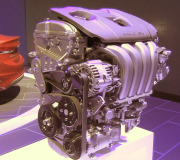Hello. Be sure that your idle circuit in the carburetor is clear and is operating properly. Be sure that the float level is precise (to the 32nd of an inch). The float level has to be roughly where it should be for the engine to perform well at all. It has to be within a 32nd of an inch of where it should be if you want perfect performance and good mileage. For instance, until recently, when I got my vibration problem in my 1951 Chevrolet, I have been able to regularily get 18 mpg in the city. Now I get 16, which isn't bad, but isn't acceptable to me, but my engine has an imbalance problem, which is sucking energy.
Be sure that your carburetor is jetted properly for the altitude in which you drive. Also be sure that there isn't any dirt in the main jet or in the idle passages. Many times I have had to pull over with a car that ran poorly at speed, and wouldn't idle, all because a tiny flake of who-knows-what got into the main jet. With the car at a stand-still and in park, accelerate the engine and note its performance. If it is shuddering and misfiring, then you need to go one or two steps richer, or possibly more. It helps to have a manual choke, because I can determine this by slowly pulling out the choke until the engine runs smoothly.
For all adjustments and troubleshooting, it is best to plug off the PCV valve until the trouble is located, unless plugging it off does not help. Never run the engine for more than 5 minutes in this condition, however, or else dangerous amounts of crankcase dillutants will build up in the oil.
Finally, regarding timing, be sure to time the engine precisely as General Motors recommends. I know there is a lot of information out there about how you should advance the timing, and how you'll get better power. All I can say is that I've tried all of this, and it only ruined my power. My 90 hp 216.5 has incredible acceleration (for its hp rating) with the stock 5 degrees BTC, and the original vacuum advance curve (full advance is at 18 inches of mercury, and advance starts at about 7 inches). Each engine is, of course, different, so those aren't your requirements. For most engines the vacuum advance doesn't even operate at idle. If you have manifold ported advance, then it will function at idle, but if it is ported at the throttle plate, it will not function at idle, so it actually doesn't even affect idle performance. Be sure that the vacuum diaphram is not leaky, as this will ruin idle, if the vacuum advance functions at idle. When the timing devices are in synchronization, however, you will get solid response both at economical cruising throttle positions, and at all (except possibly wide open) power throttle positions.
If your cam has a duration at all longer than the original cam, this can also diminish vacuum, and make the idle rough/difficult to manage. That is why modern cars sometimes have variable valve timing, which takes advantage of both a wide cam and a regular cam, so the engine has good response and smooth performance. When my brother used to work on muscle cars in the 90s, I always thought that this would be a good idea--use a governor of sorts to operate cams and such on the cams to widen their lift period. Seems that auto manufacturers thought of this, too, though. Aw. I could have made a lot of money on that idea! I'm surprised that it took auto manufacturers 100 years to figure that out.
SPONSORED LINKS
Tuesday, September 18th, 2007 AT 8:47 AM




